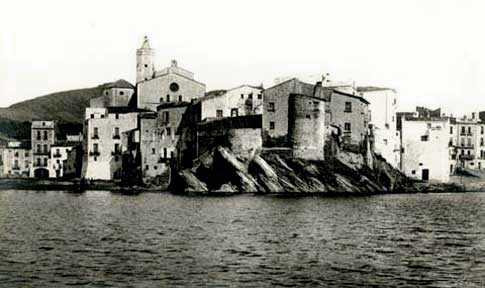Parish Church of Santa María
We start the visit in front of the façade of the Parish Church of Santa María (16th and 17th centuries). Due to its elevated position, it is a viewpoint over the bay and the surrounding area. This temple that we see in Cadaqués was built over the remains of the one destroyed in 1543 by Barbarossa and still retains some Gothic elements.
Inside, the Baroque Capella Fonda and the astonishing main altarpiece of the Virgen de la Esperanza stand out. The altarpiece was saved in 1936 by the imaginative initiative of building a wall in front of it. It also contains a 17th century Baroque organ which is included in everything you see in Cadaqués.
Salvador Dalí and his inspiration
In the 1940s Salvador Dalí began to build his house in Port Lligat. He fell in love with this place in 1930 and first occupied a fisherman’s hut. He lived there until the death of his wife Gala in 1982. This house is a real labyrinth that always leads to one of the most common landscapes in the artist’s dreamlike visions: the bay of Port Lligat.
The place is now the home of the Salvador Dalí House Museum and a visit to it helps to understand his most intimate life and the studios where he worked. It is complemented by the so-called Cadaqués Museum, which also focuses on the figure of this Catalan artist. These are two emblematic places to see in Cadaqués.
The Ermita de San Baldirio (early 18th century) is still linked to the town’s seafaring life. It is the heir to a prayer room erected as a gesture of gratitude to Pope Pius V for his help in the battle of Lepanto to put an end to the piracy that affected this coast so much. It is another of the temples to be seen in Cadaqués.
A walk through its streets
Built into the Town Hall, in the Silví Rahola street, you can see part of the structure of the medieval wall, which has practically disappeared.
Along the streets you can see many modernist style houses, often built by indianos. For example, the Casa Blaua and of the Rahola, as well as the Colom Tower. In a classicist style, it is one of the leisure centres of 19th century bourgeois society: the Casino de la Amistad.
In the public spaces of this town there are several sculptures to be seen in Cadaqués. That is, the one signed by Dalí himself and located in Porlligat: La barca y el ciprés. Also of great interest is the female figure that the famous modernist sculptor Josep Llimona placed in the town’s cemetery. A cultural visit to make in Cadaqués that you cannot miss.

Cadaqués with Santa María Church in the background.
In the vicinity of the port is the Cala Nans lighthouse (19th century), complemented by a small dock. Likewise, the Espai Cap de Creus has its headquarters in a magnificent Faro (1853). It is one of the oldest lighthouses on the Catalan coast. There the visitor can understand the geological and natural richness of this protected landscape in the surroundings of Cadaqués.






